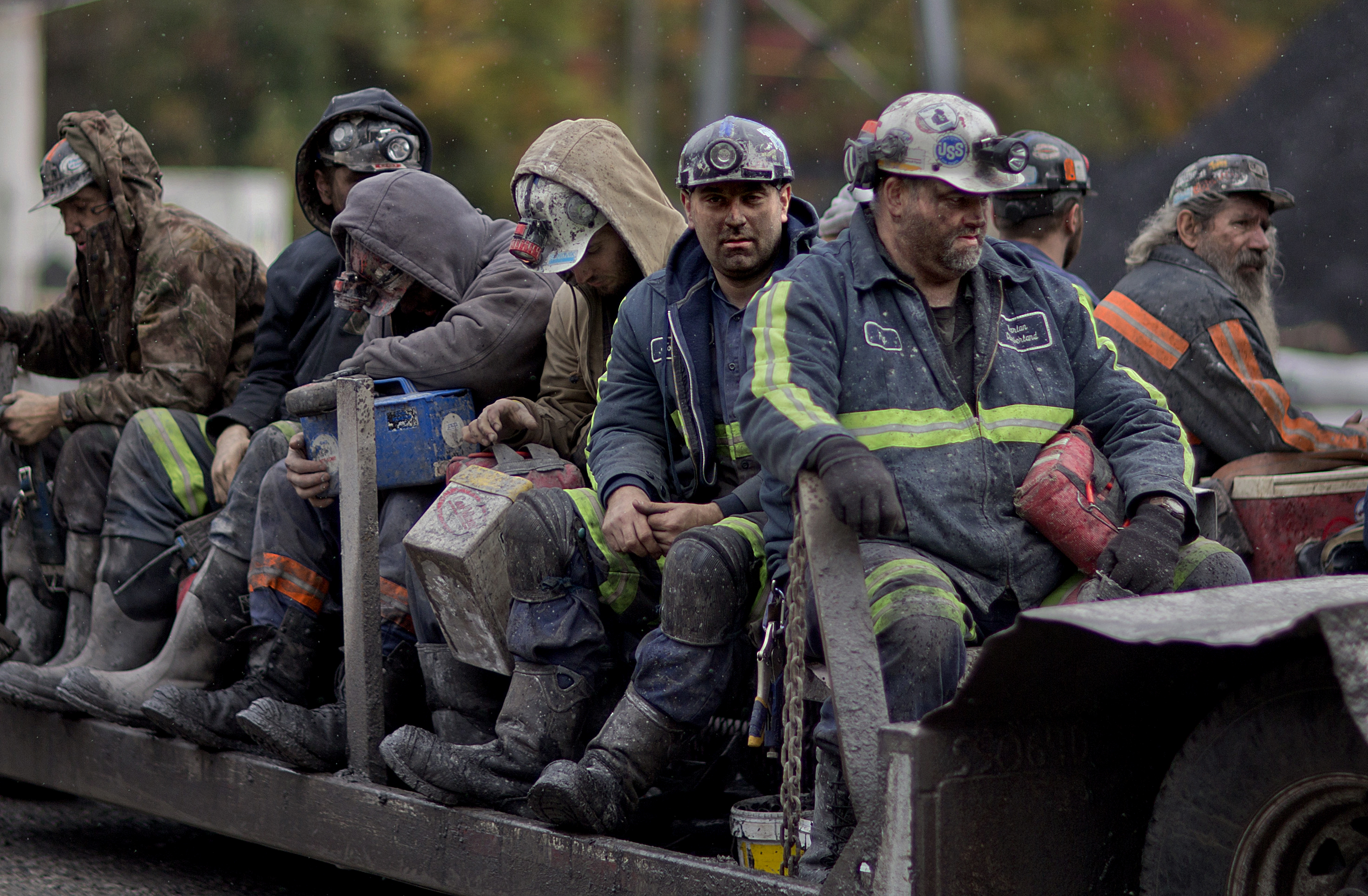Corrections and Clarifications: This story previously misstated the role of Jim Mesterharm in Walter Energy's restructuring.
The crushing forces prevailing against the U.S. coal industry have triggered an unprecedented shakeout, sparking bankruptcies of the industry’s biggest players — such as last week's collapse of Peabody Energy — and battering jobs in Appalachia even as mines in the west weather the fallout.
Peabody, the nation's largest coal company, slid into Chapter 11 bankruptcy last week, just five years after its market value reached a high of $20 billion, as the oil and natural gas shale boom shifts the seat of power to miners in states such as Montana and Wyoming, where extracting coal is cheaper.
Peabody's bankruptcy filing follows at least 50 in the industry over the last few years including Arch Coal in January and last year's filings of Patriot Coal, Alpha Natural Resources and Walter Energy.
In West Virginia — the heart of American coal country — production may hit lows in 2016 that have not been seen since crippling strikes rippled through the region in the late 1970's, according to West Virginia University economist projections. The state's economy has already lost more than 35% of its coal jobs since 2011 — and that number is expected to continue rising.
West Virginia state labor officials project a 23% decline in non-oil-and-gas mining jobs from 2015 to 2017. In Kentucky, the number of coal mining jobs plummeted 28% in 2015 to 8,401, according to state figures.
Nationally, the number of coal jobs was 56,700 in March, down from a high of 178,300 in April 1985, according to U.S. government data. There are indications that surviving mines are cutting positions to part-time, as well.
The reasons for coal's troubles are many. The rise of natural gas during the oil and shale rush tops the list. Then there's China's reduced use of coal and heavy debt accumulated through a wave of industry consolidation and a corresponding borrowing binge in recent years. Finally, costs associated with environmental regulation have made it prohibitively expensive for certain mines to remain in operation, leading some to simply shut down altogether.
Add to that aging Appalachian mines that make extraction difficult and expensive. The result is the displacement of an industry that, in many ways, defined a region and provided thousands of jobs to its residents.
"It’s not just the miners’ jobs that are impacted — it's all the companies that supply the mines and are dependent on the local economies driven by coal-miner salaries," says Jim Mesterharm, managing director of the North America restructuring practice at AlixPartners, who served as a restructuring adviser to Walter Energy.
"There is a lot of displacement that’s occurring in that industry," he says. "So people who earned a very good living mining coal — they’ll need job training to be able to reposition themselves in the workforce as those jobs continue to fade away."
Go West, old industry
Hours worked by miners in central Appalachia — which encompasses northeastern Kentucky, southern Ohio and northwestern West Virginia — fell by 52% from 2012 to 2015, according to government data. In southern Appalachia hours worked are down 32%, and in northern Appalachia hours worked have fallen 22%.
Meanwhile, coal production and jobs in newer mines — namely, operations in the cheaper-to-mine Powder River Basin in Wyoming and Montana — have remained steadier. In fact, coal production in the Powder River Basin is expected to rise by 13.5% from 2016 through 2021, according to the U.S. Energy Information Administration's (EIA) Annual Energy Outlook.
"We see central Appalachian thermal coal as dying," IHS coal analyst James Stevenson said. "The center of gravity of U.S. coal mining is moving westward."
To be sure, no one expects coal to go away immediately. In fact, the EIA projects that coal will still represent 20% of electricity generation by 2040 — which industry experts say is because cheap coal will remain available in some areas and utility companies aren't capable of immediately transitioning their entire power plant footprint to natural gas or renewable energy sources.
But the sliding reliance on coal is undeniable. Coal generated one-third of U.S. electricity in 2015, losing about 5 percentage points from its 2014 level, according to the EIA. Conversely, natural gas gained about 5 percentage points during that period, generating nearly one-third of U.S. electricity last year.
As recently as 2000, the U.S. burned more than three times as much coal as it did natural gas.
Appalachia costs high
Although it's still the largest coal producing region of the country, Appalachia is suffering from old age.
Easy-to-mine coal throughout West Virginia is largely gone — having been removed many years ago — and now it's costlier to extract the commodity.
Appalachian miners are "having to dig a little deeper into thinner seams to get the coal out," EIA coal analyst Greg Adams said. "It's high-quality coal, but it’s more expensive to mine."
Alpha Natural Resources, for example, spent nearly six times more per ton to extract coal from its Appalachian mines than it did in its western mines in the second quarter of 2015, the most recent available data, according to a public filing. That triggered a loss of $277 million in the east, even as the west posted a $4.3 million profit.
Spot prices of coal in northern and central Appalachia were $46.60 per ton and $42.30, respectively, in the week ended April 8, according to the EIA. Coal mined from the Powder River Basin in Wyoming and Montana are $9.35 per ton. Transportation costs from region lessen the bargain, but not for all buyers.
The biggest risk for coal miners is that this confluence of challenges will make it more sensible to close mines than to continue operating.
The Powder River basin's North Antelope Rochelle mine is "the world's largest and most productive coal mine," according to a Peabody court filing. At that mine, Peabody employs 1,150 workers in two 12-hour shifts per day, 365 days per year.
Peabody spokesperson Beth Sutton said in an email that the company's bankruptcy would have "no effect on jobs, and our operations continue business-as-usual," though she said production is constantly adjusted to meet market demand.
China takes toll
Another significant factor battering U.S. coal companies is the tepid economy in China and the country's stated intent to reduce carbon emissions in power generation.
China's consumption of a type of coal used in steel-making, called metallurgical coal, took off as the country's manufacturing sector boomed and construction soared. Many companies charted growth strategies, particularly through debt-fueled acquisitions and export plans, to serve the Chinese market.
U.S. exports of coal — which includes China — fell 41.2% from 2012 to 2015, dipping to 74 million tons, the lowest since the Great Recession in 2009, according to the EIA.
"All of a sudden you had the largest consumer cutting back, which then creates excess supply because you had people who brought a lot of extra capacity online," AlixPartners' Mesterharm said.
What's more, many coal companies are facing pressure from regulators over funds for mine restoration and regulations such as the U.S. Environmental Protection Agency's attempts to slash harmful emissions from coal-fired power plants.
Under federal laws and state rules, coal companies are required to pay for restoration costs — either through issuing bonds to cover future cleanup or proving their financial capability to handle forthcoming environmental obligations, such as returning stripped-off-mountaintops to their original state.
"These are obligations that are materially underfunded and require significant capital to take care of," said Zachary Bader, a distressed debt analyst for Reorg Research who has been tracking coal bankruptcies.
But when coal companies end up in bankruptcy, communities, politicians and environmentalists fear that they will slash those obligations, leaving taxpayers to foot the bill for cleanup. Peabody alone has $723 million in reclamation obligations, according to its bankruptcy filing.
All told, it's a tough position for the industry, said Stephen Hessler, a Kirkland & Ellis bankruptcy attorney who represented Patriot Coal and currently represents certain creditors in the Alpha Natural Resources and Peabody cases.
"Coal companies are getting buffeted from all sides," Hessler said.
Follow USA TODAY reporter Nathan Bomey on Twitter @NathanBomey.
Recent coal industry layoffs
The shakeout in coal is triggering layoffs at many companies, including these recent ones with the scheduled date of cuts:
April 26: Arch Coal said it would lay off 140 workers in Cowen, W.V.
April 26: Alpha Natural Resources plans to cut 123 jobs in Iaeger, W.V., and Panther, W.V.
April 5: Warrior Coal cut 150 jobs in Hopkins County, Ky.
April 5: Hopkins County Coal cut 253 jobs in Hopkins County, Ky.
March 25: Alpha slashed 508 positions in Naoma, W.V., and Whitesville, W.V.
March 11: Blackhawk Mining laid off 146 in Eskdale, W.V., and in Gilbert, W.V., and Lyburn, W.V.
Feb. 19: Carter Roag Coal laid off 173 in Mill Creek, W.V.
Feb. 18: Walter Energy cut 120 jobs in Powellton, W.V. and Summersville, W.V.
Nov. 20: Alpha shed 527 positions in November at operations in Clintwood, Va., and Nora, Va.
2014-15: Patriot Coal shed several hundred jobs in Appalachia, eventually selling off its assets in a bankruptcy deal to Blackhawk Mining and an affiliate of the Virginia Conservation Legacy Fund.
Sources: Worker Adjustment and Retraining Notification (WARN) Act notices


